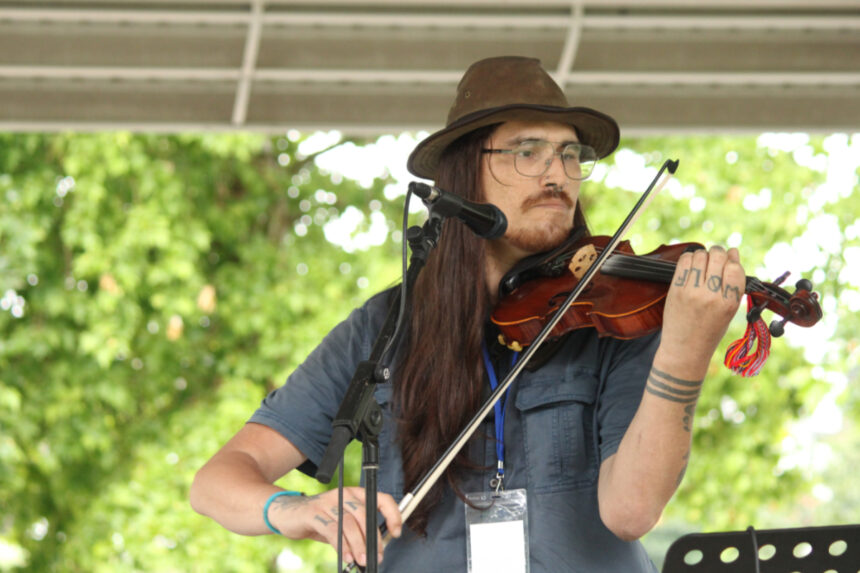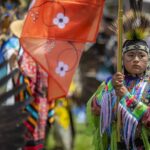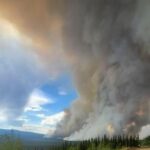The drumming started softly, then built to a thunderous crescendo that seemed to ripple through the gathering crowd at Maffeo Sutton Park. Children stopped their playing, adults paused mid-conversation, and for a moment, the bustling waterfront in downtown Nanaimo fell silent except for that ancient rhythm.
“This is how we’ve called our people together for thousands of years,” explained Elder Lolly Good of Snuneymuxw First Nation, her voice carrying across the park as hundreds gathered to celebrate National Indigenous Peoples Day. “The drum represents the heartbeat of Mother Earth.”
I arrived at the park just before noon yesterday, the summer solstice marking both the longest day of the year and a nationwide celebration of Indigenous cultures. The park had transformed into a vibrant community space where the traditional territories of the Coast Salish peoples were honored through song, dance, art, and storytelling.
Families spread blankets on the grass while vendors lined pathways with displays of intricate beadwork, cedar weavings, and contemporary Indigenous art. The air carried the unmistakable aroma of salmon being prepared over open fires using traditional cooking methods.
For Geraldine Manson, another respected Snuneymuxw Elder who has helped organize this celebration for over a decade, the day represents both cultural resilience and a chance for community education.
“Today isn’t just for Indigenous peoples,” Manson told me as we watched young dancers prepare for their performance. “It’s for everyone to learn about our ways, our history on this land, and our vision for the future. When I was a child, we couldn’t practice our ceremonies openly. Now my grandchildren dance proudly in public.”
The Nanaimo event, one of dozens across Vancouver Island, has grown substantially in recent years. According to the Nanaimo Aboriginal Centre, attendance has more than tripled since 2015, with approximately 2,000 people participating throughout the day-long celebration.
This growth reflects broader shifts in Canadian society. Statistics Canada reports that between 2006 and 2021, the self-identified Indigenous population increased by 73.7% – growing at more than twice the rate of the non-Indigenous population. In British Columbia specifically, urban centers like Nanaimo have seen significant growth in Indigenous communities.
Chris Beaton, executive director of the Nanaimo Aboriginal Centre, believes the increased attendance also signals changing attitudes.
“Ten years ago, you might have seen mostly Indigenous families here,” Beaton explained, gesturing toward the diverse crowd. “Today, we see school groups, tourists, newcomers to Canada – people seeking to understand the true history and living cultures of this place.”
The day’s performances showcased that living culture through traditional and contemporary expressions. The youth dance group from Snuneymuxw performed alongside visiting dancers from Kwakwaka’wakw territories to the north. Later, Indigenous hip-hop artists and spoken word performers took the stage, demonstrating how cultural identity continues evolving while remaining rooted in ancestral knowledge.
Near the harbor’s edge, I met Richard Williams, a master carver from Snuneymuxw, who was demonstrating traditional cedar carving techniques. His hands moved with practiced precision as he shaped a ceremonial talking stick.
“When I carve, I’m not just making art – I’m continuing a conversation with my ancestors,” Williams said. “Each cut connects me to thousands of years of knowledge. Today, I’m teaching these techniques to my grandson.”
Williams pointed to a teenage boy nearby who was carefully sanding a small paddle. “He’s the seventh generation of carvers in our family. That’s what today celebrates – not just our survival, but our thriving.”
The celebration occurs within a complex context. While cultural pride was evident throughout the park, many speakers acknowledged ongoing challenges. A recent report from British Columbia’s First Nations Health Authority highlighted persistent disparities in health outcomes and access to services for Indigenous communities across the province.
“We gather in celebration, but we also gather in recognition of work still to be done,” said Snuneymuxw Chief Michael Wyse during the opening ceremonies. “True reconciliation means addressing the systemic barriers our people still face while strengthening our languages, our governance systems, and our connection to traditional territories.”
That connection to territory was emphasized through food. Long tables featured traditional foods harvested from local waters and forests – salmon, crab, venison, berries, and more – prepared by knowledge keepers who explained the cultural significance and sustainable harvesting practices behind each dish.
“Our food systems are inseparable from our identity,” explained Stella Johnson, who coordinated the food sharing. “When we gather to eat foods that have sustained our people for countless generations, we’re not just satisfying hunger. We’re teaching our children about reciprocity with the land and strengthening our community bonds.”
As evening approached, the celebration culminated with a community feast where everyone – Indigenous and non-Indigenous alike – was invited to share a meal. Children raced between tables, elders shared stories, and strangers became acquaintances over plates of traditionally prepared food.
Watching this scene unfold, Elder Lolly Good reflected on the day’s significance: “When I was young, I was taught to hide my culture. Now I watch my great-grandchildren singing our songs in public, speaking our language without fear. That’s the power of days like today – they help heal wounds across generations.”
As the summer sun began its slow descent over Nanaimo’s harbor, the drumming resumed – softer now, but no less powerful. Families gathered their belongings, exchanged contact information with new friends, and promised to return next year. The celebration was ending, but the cultural resurgence it represents continues growing stronger with each passing season.






